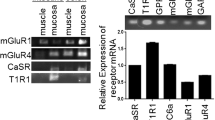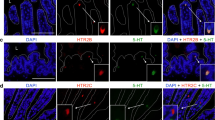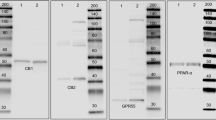Abstract
Short-chain fatty acids (SCFAs), such as acetate, propionate, and butyrate, are the major anions in the large intestinal lumen. They are produced from dietary fiber by bacterial fermentation and are known to have a variety of physiological and pathophysiological effects on the intestine. In the present study, we investigated the expression of the SCFA receptor, GPR43, in the rat distal ileum and colon. Expression of GPR43 was detected by reverse transcriptase/polymerase chain reaction (RT-PCR), Western blotting, and immunohistochemistry. mRNA for GPR43 was detected, by RT-PCR, in extracts of the whole wall and separated mucosa from the ileum and colon and from muscle plus submucosa from the ileum, but not from muscle plus submucosa preparations from the colon. We raised a rabbit antiserum against a synthesized fragment of rat GPR43; this was specific for rat GPR43. GPR43 protein was detected by Western blot analysis in extracts of whole wall and separated mucosa, but not in muscle plus submucosa extracts. By immunohistochemistry, GPR43 immunoreactivity was localized to enteroendocrine cells expressing peptide YY (PYY), whereas 5-hydroxytryptamine (5-HT)-immunoreactive (IR) enteroendocrine cells were not immunoreactive for GPR43. Mast cells of the lamina propria expressing 5-HT were also GPR43-IR. The results of the present study suggest that the PYY-containing enteroendocrine cells and 5-HT-containing mucosal mast cells sense SCFAs via the GPR43 receptor. This is consistent with physiological data showing that SCFAs stimulate the release of PYY and 5-HT from the ileum and colon.







Similar content being viewed by others
References
Brown AJ, Goldsworthy SM, Barnes AA, Eilert MM, Tcheang L, Daniels D, Muir AI, Wigglesworth MJ, Kinghorn I, Fraser NJ, Pike NB, Strum JC, Steplewski KM, Murdock PR, Holder JC, Marshall FH, Szekeres PG, Wilson S, Ignar DM, Foord SM, Wise A, Dowell SJ (2003) The orphan G protein–coupled receptors GPR41 and GPR43 are activated by propionate and other short chain carboxylic acids. J Biol Chem 278:11312–11319
Cherbut C, Aube AC, Blottiere HM, Galmiche JP (1997) Effects of short–chain fatty acids on gastrointestinal motility. Scand J Gastroenterol Suppl 222:58–61
Cherbut C, Ferrier L, Roze C, Anini Y, Blottiere H, Lecannu G, Galmiche JP (1998) Short–chain fatty acids modify colonic motility through nerves and polypeptide YY release in the rat. Am J Physiol 275:G1415–G1422
Cuche G, Cuber JC, Malbert CH (2000) Ileal short–chain fatty acids inhibit gastric motility by a humoral pathway. Am J Physiol Gastrointest Liver Physiol 279:G925–G930
Cummings JH, Rombeau JL, Sakata T (1995) Physiological and clinical aspects of short–chain fatty acids. Cambridge University Press, Cambridge
El–Salhy M, Grimelius L, Wilander E, Ryberg B, Terenius L, Lundberg JM, Tatemoto K (1983) Immunocytochemical identification of polypeptide YY (PYY) cells in the human gastrointestinal tract. Histochemistry 77:15–23
Facer P, Polak JM, Jaffe BM, Pearse AG (1979) Immunocytochemical demonstration of 5–hydroxytryptamine in gastrointestinal endocrine cells. Histochem J 11:117–121
Fukumoto S, Tatewaki M, Yamada T, Fujimiya M, Mantyh C, Voss M, Eubanks S, Harris M, Pappas TN, Takahashi T (2003) Short–chain fatty acids stimulate colonic transit via intraluminal 5–HT release in rats. Am J Physiol Regul Integr Comp Physiol 284:R1269–R1276
Le Poul E, Loison C, Struyf S, Springael JY, Lannoy V, Decobecq ME, Brezillon S, Dupriez V, Vassart G, Van Damme J, Parmentier M, Detheux M (2003) Functional characterization of human receptors for short chain fatty acids and their role in polymorphonuclear cell activation. J Biol Chem 278:25481–25489
Lin HC, Doty JE, Reedy TJ, Meyer JH (1990) Inhibition of gastric emptying by sodium oleate depends on length of intestine exposed to nutrient. Am J Physiol 259:G1031–G1036
Lin HC, Zhao XT, Wang L, Wong H (1996) Fat–induced ileal brake in the dog depends on peptide YY. Gastroenterology 110:1491–1495
Lin HC, Neevel C, Chen PS, Suh G, Chen JH (2003) Slowing of intestinal transit by fat or peptide YY depends on beta–adrenergic pathway. Am J Physiol Gastrointest Liver Physiol 285:G1310–G1316
Lin HC, Neevel C, Chen JH (2004) Slowing intestinal transit by PYY depends on serotonergic and opioid pathways. Am J Physiol Gastrointest Liver Physiol 286:G558–G563
Longo WE, Ballantyne GH, Savoca PE, Adrian TE, Bilchik AJ, Modlin IM (1991) Short–chain fatty acid release of peptide YY in the isolated rabbit distal colon. Scand J Gastroenterol 26:442–448
Lundberg JM, Tatemoto K, Terenius L, Hellstrom PM, Mutt V, Hokfelt T, Hamberger B (1982) Localization of peptide YY (PYY) in gastrointestinal endocrine cells and effects on intestinal blood flow and motility. Proc Natl Acad Sci USA 79:4471–4475
Mitsui R, Ono S, Karaki S, Kuwahara A (2005) Neural and non–neural mediation of propionate–induced contractile responses in the rat distal colon. Neurogastroenterol Motil 17:585–594
Ono S, Karaki S, Kuwahara A (2004) Short–chain fatty acids decrease the frequency of spontaneous contractions of longitudinal muscle via enteric nerves in rat distal colon. Jpn J Physiol 54:483–493
Resta Lenert S, Truong F, Barrett KE, Eckmann L (2001) Inhibition of epithelial chloride secretion by butyrate: role of reduced adenylyl cyclase expression and activity. Am J Physiol Cell Physiol 281:C1837–C1849
Squires PE, Rumsey RD, Edwards CA, Read NW (1992) Effect of short–chain fatty acids on contractile activity and fluid flow in rat colon in vitro. Am J Physiol 262:G813–G817
Umesaki Y, Yajima T, Yokokura T, Mutai M (1979) Effect of organic acid absorption on bicarbonate transport in rat colon. Pflugers Arch 379:43–47
Yajima T (1985) Contractile effect of short–chain fatty acids on the isolated colon of the rat. J Physiol (Lond) 368:667–678
Yajima T (1988) Luminal propionate–induced secretory response in the rat distal colon in vitro. J Physiol (Lond) 403:559–575
Yu PL, Fujimura M, Okumiya K, Kinoshita M, Hasegawa H, Fujimiya M (1999) Immunohistochemical localization of tryptophan hydroxylase in the human and rat gastrointestinal tracts. J Comp Neurol 411:654–665
Author information
Authors and Affiliations
Corresponding author
Additional information
This study was supported by the Promotion of Health and Nutrition from the Danone Institute, by an AstraZeneca Research Grant, and by the Australian Research Council (grant #DP0557307).
Rights and permissions
About this article
Cite this article
Karaki, Si., Mitsui, R., Hayashi, H. et al. Short-chain fatty acid receptor, GPR43, is expressed by enteroendocrine cells and mucosal mast cells in rat intestine. Cell Tissue Res 324, 353–360 (2006). https://doi.org/10.1007/s00441-005-0140-x
Received:
Accepted:
Published:
Issue Date:
DOI: https://doi.org/10.1007/s00441-005-0140-x




